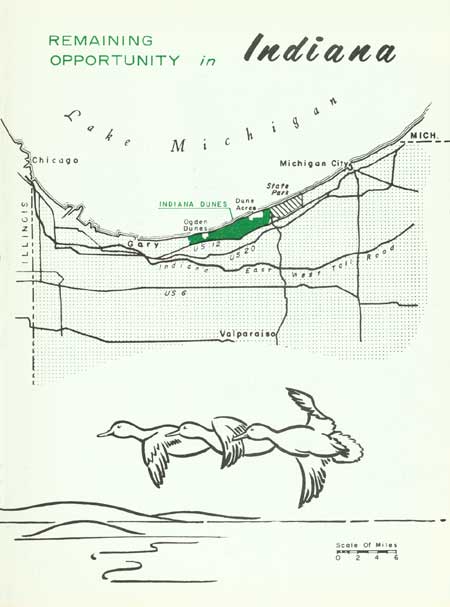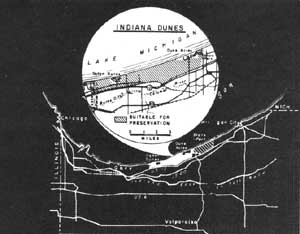|
NATIONAL PARK SERVICE
Great Lakes Shoreline Recreation Area Survey |

|
REMAINING OPPORTUNITIES IN INDIANA

|
| Remaining Opportunities in Indiana (Vicinity Map) (click on image for an enlargement in a new window) |
SUMMARY
The area around Indiana's 45 miles of frontage on Lake Michigan has long been an arena where recreational, residential and industrial interests have jousted for control. Location, terrain and resources are favorable for all three, but space is insufficient to supply the maximum demands of each.
In 1916, Stephen Mather, serving as Director of the National Park Service, recommended establishment of a National Park in this area. At that time, the site under consideration contained a 25-mile strip of uninhabited sand beach backed up by 15 square miles of tree-covered dunes and wildlife marshes. But World War I intervened, and the same features that appealed to nature enthusiasts also encouraged residential development. Before concrete action on the federal park project could be resumed, two communities (Ogden Dunes and Dune Acres) became solidly established in the heart of the area.
In 1923, however, local and state conservation groups succeeded in establishing Indiana Dunes State Park, thus securing three miles of excellent beach plus 2,200 acres of dunes and marshland for public use and enjoyment. The popularity of this outstanding park has increased steadily and the existing facilities are no longer able to handle the crowds. Last July 4th the overcrowded conditions necessitated turning hundreds of people away because of inadequate facilities to accommodate them. The state now plans to provide additional beach access at the east end of the park where a minimum alteration will be made on the natural scene. However, to meet the ever increasing demands of the future, more space will be needed unless the splendid natural values--for which this park was established to preserve--are to be impaired by replacing some of the dunes with parking areas and converting forest area to campsites and picnic grounds.
Today, only five and one-half miles of undeveloped shoreline and about 5,000 acres remain which are suitable of consideration for public acquisition and control. Much of this area is owned by industrial corporations that have plans for utilizing this space for steel mill sites. In conjunction with such operations, there are pressures to create a major harbor development in the area. This latter project is designed to give Indiana's production and economy a "place on the sea"--an increased opportunity to benefit from advantages offered by the St. Lawrence Seaway.
It is estimated that by 1960 nearly 1 million people--or about one-fifth of Indiana's citizens--will be living within 50 miles of this shoreline. Across the line in Illinois another 6 million people will be clamoring for outdoor recreational space--especially of the beach type. Rapidly increasing population growth is going to make future recreation needs even greater. The conversion of the following undeveloped shoreline to park use would aid materially in meeting a part of these recreation needs. Also, such action would serve to preserve the natural values there as well as those in the Indiana Dunes State Park.

| INDIANA |
INDIANA DUNES

LOCATION Indiana's undeveloped Lake Michigan shoreline is located in Porter County between its western boundary and Indiana Dunes State Park. It is bounded on the south by the main lines of the New York Central and Chicago South Shore railroads. Access is available over several roads just south of the area which funnel into Chicago, 35 miles to the west. Excluding the communities of Ogden Dunes and Dune Acres, this study area encompasses 5-1/2 miles of shoreline backed up by 5,000 acres of beach, dunes, woodland and marshes.
DESCRIPTION The shallow waters are warm enough for pleasant swimming for several months each summer. The clean, white sand beaches vary in width with the level of Lake Michigan but are seldom less than 200 feet wide. Rising behind the beaches are the sand dunes, some reaching more than 100 feet above the lake. Behind the barrier dunes lie marshes interspersed with cross ridges of tree-covered dunes.
This region along southern Lake Michigan lies in a belt where a number of plants and animals are associated near their northern or southern limits of distribution. Several reptiles and amphibians are near the periphery of their northern range. The flowering dogwood of more southern climes mingles with the white pine, a characteristic tree of the northern Great Lakes. Part of the floral composition is also associated with the prairie peninsula. Bogs and marshes behind the dunes provide a habitat for a variety of marsh plants, while on the dunes and other sandy areas a number of Atlantic Coastal Plain plants appear.
PRESENT USE In two separate locations, over 350 acres of duneland have been leveled or altered by sand removal operations with their attendant railroad sidings and grading activities. A half mile east of Ogden Dunes is Burns Ditch. Originally constructed as a drainage channel, it is utilized today primarily as a passage and harbor for private pleasure boats. Between Dune Acres and Ogden Dunes, a large number of frame cottages are scattered along the barrier dune. The natural character of the dunes has been further altered by annual forest fires that have ranged over much of the dunes and marshes during the past two decades.
ANALYSIS Few other places on the Great Lakes exhibit a greater need for additional recreation sites than the vast Chicago Metropolitan Area. This remaining portion of Lake Michigan shoreline represents a potential major contribution toward the fulfillment of these recreational needs. Its early acquisition for park uses would be in the best interest of public recreation.

|
| Indiana Dunes |
| <<< Previous | <<< Contents>>> | Next >>> |
rec_area_survey/gl/in.htm
Last Updated: 27-Jun-2007